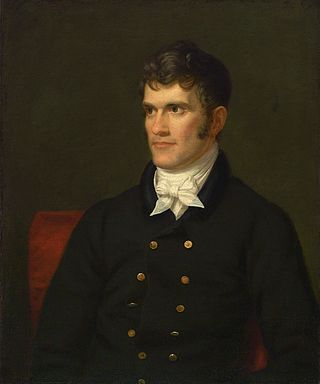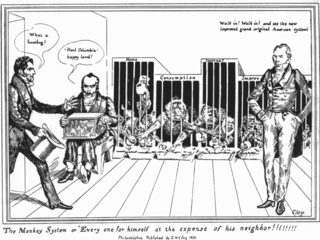Related Research Articles
The Tariff of 1828 was a very high protective tariff that became law in the United States on May 19, 1828. It was a bill designed to fail in Congress because it was seen by free trade supporters as hurting both industry and farming, but it passed anyway. The bill was vehemently denounced in the South and escalated to a threat of civil war in the Nullification Crisis of 1832–33. The tariff was replaced in 1833, and the crisis ended. It was called the "Tariff of Abominations" by its Southern detractors because of the effects it had on the Southern economy. It set a 38% tax on some imported goods and a 45% tax on certain imported raw materials.

The Force Bill, formally titled "An Act further to provide for the collection of duties on imports", 4 Stat. 632 (1833), refers to legislation enacted by the 22nd U.S. Congress on March 2, 1833, during the nullification crisis.
The Morrill Tariff was an increased import tariff in the United States that was adopted on March 2, 1861, during the administration of US President James Buchanan, a Democrat. It was the twelfth of the seventeen planks in the platform of the incoming Republican Party, which had not yet been inaugurated, and the tariff appealed to industrialists and factory workers as a way to foster rapid industrial growth.

The nullification crisis was a sectional political crisis in the United States in 1832 and 1833, during the presidency of Andrew Jackson, which involved a confrontation between the state of South Carolina and the federal government. It ensued after South Carolina declared the federal Tariffs of 1828 and 1832 unconstitutional and therefore null and void within the sovereign boundaries of the state.
The Ordinance of Nullification declared the Tariffs of 1828 and 1832 null and void within the borders of the U.S. state of South Carolina, beginning on February 1, 1833. It began the Nullification Crisis. Passed by a state convention on November 24, 1832, it led to President Andrew Jackson's proclamation against South Carolina, the Nullification Proclamation on December 10, 1832, which threatened to send government troops to enforce the tariffs. In the face of the military threat, and following a Congressional revision of the law which lowered the tariff, South Carolina repealed the ordinance.
The American School, also known as the National System, represents three different yet related constructs in politics, policy and philosophy. The policy existed from the 1790s to the 1970s, waxing and waning in actual degrees and details of implementation. Historian Michael Lind describes it as a coherent applied economic philosophy with logical and conceptual relationships with other economic ideas.

The South Carolina Exposition and Protest, also known as Calhoun's Exposition, was written in December 1828 by John C. Calhoun, then Vice President of the United States under John Quincy Adams and later under Andrew Jackson. Calhoun did not formally state his authorship at the time, though it was widely suspected and later confirmed.

Robert Young Hayne was an American politician. He served in the United States Senate from 1823 to 1832, as Governor of South Carolina 1832–1834, and as Mayor of Charleston 1836–1837. As Senator and Governor, he was a leading figure in the Nullification Crisis and, along with John C. Calhoun and James Hamilton Jr., a vocal proponent of the doctrines of states' rights, compact theory, and nullification; his 1830 debate in the Senate with Daniel Webster is considered a defining episode in the constitutional crisis which precipitated the American Civil War.
The Tariff of 1824 was a protective tariff in the United States designed to protect American industry from cheaper British commodities, especially iron products, wool and cotton textiles, and agricultural goods.

The Tariff of 1833, enacted on March 2, 1833, was proposed by Henry Clay and John C. Calhoun as a resolution to the Nullification Crisis. Enacted under Andrew Jackson's presidency, it was adopted to gradually reduce the rates following Southerners' objections to the protectionism found in the Tariff of 1832 and the 1828 Tariff of Abominations; the tariffs had prompted South Carolina to threaten secession from the Union. This Act stipulated that import taxes would gradually be cut over the next decade until, by 1842, they matched the levels set in the Tariff of 1816—an average of 20%. The compromise reductions lasted only two months into their final stage before protectionism was reinstated by the Black Tariff of 1842.
The Tariff of 1842, or Black Tariff as it became known, was a protectionist tariff schedule adopted in the United States. It reversed the effects of the Compromise Tariff of 1833, which contained a provision that successively lowered the tariff rates from their level under the Tariff of 1832 over a period of ten years until the majority of dutiable goods were to be taxed at 20%.
A concurrent majority is a majority composed of majorities within various subgroups. As a system of government, it means that "major government policy decisions must be approved by the dominant interest groups directly affected ... each group involved must give its consent". There must be majority support within each affected group concurrently.
The Nullifier Party was an American political party based in South Carolina in the 1830s. Considered an early American third party, it was started by John C. Calhoun in 1828.
Tariffs have historically served a key role in the trade policy of the United States. Their purpose was to generate revenue for the federal government and to allow for import substitution industrialization by acting as a protective barrier around infant industries. They also aimed to reduce the trade deficit and the pressure of foreign competition. Tariffs were one of the pillars of the American System that allowed the rapid development and industrialization of the United States.

The American System was an economic plan that played an important role in American policy during the first half of the 19th century, rooted in the "American School" ideas of Alexander Hamilton.

The presidency of Andrew Jackson began on March 4, 1829, when Andrew Jackson was inaugurated as 7th President of the United States, and ended on March 4, 1837. Jackson took office after defeating incumbent President John Quincy Adams in the bitterly contested 1828 presidential election. During the 1828 presidential campaign, Jackson founded the political force that coalesced into the Democratic Party during Jackson's presidency. Jackson won re-election in 1832, defeating National Republican candidate Henry Clay by a wide margin. He was succeeded by his hand-picked successor, Vice President Martin Van Buren, after Van Buren won the 1836 presidential election.
The Proclamation to the People of South Carolina was written by Edward Livingston and issued by Andrew Jackson on December 10, 1832. Written at the height of the Nullification Crisis, the proclamation directly responds to the Ordinance of Nullification passed by the South Carolina legislature in November 1832. Its purpose was to subdue the Nullification Crisis created by South Carolina's ordinance and to denounce the doctrine of nullification.
Protectionism in the United States is protectionist economic policy that erects tariffs and other barriers on imported goods. This policy was most prevalent in the 19th century. At that time, it was mainly used to protect Northern industries and was opposed by Southern states that wanted free trade to expand cotton and other agricultural exports. Protectionist measures included tariffs and quotas on imported goods, along with subsidies and other means, to restrain the free movement of imported goods, thus encouraging local industry.
Protective tariffs are tariffs that are enacted with the aim of protecting a domestic industry. They aim to make imported goods cost more than equivalent goods produced domestically, thereby causing sales of domestically produced goods to rise, supporting local industry. Tariffs are also imposed in order to raise government revenue, or to reduce an undesirable activity. Although a tariff can simultaneously protect domestic industry and earn government revenue, the goals of protection and revenue maximization suggest different tariff rates, entailing a tradeoff between the two aims.
The United States Senate Select Committee on the Tariff Regulation was a Select Committee for the U.S. Senate from February 25, 1823 until March 3, 1923. It is now a defunct congressional committee, having been consolidated into the Committee of Finance in 1923.
References
- ↑ Frank Taussig, Tariff History of the United States (1912) online
- ↑ "To Put the Main Question on Passage of H.R. 584". GovTrack. Retrieved May 7, 2019.